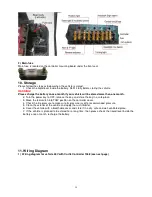
13
3) NO FOREIGN MATTER
Do not place any objects on the battery and do not connect the positive pole to the negative pole. This may
cause a short circuit, dangerous spark or may cause damage to the battery or injury to your body.
4) RECHARGING
a. As long as you use the vehicle, regardless of how long you have used it, the battery shall be
recharged fully on the same day. Any delay in re-charging will cause a negative effect on the battery.
Notes
: The lead-acid battery does not develop a memory, so there is no need to be fully discharged
before recharging.
b. If the vehicle is going to be kept unused for a long period the battery should be fully recharged first.
After that, the battery shall be fully recharged every 2 weeks.
c. When driving, the driver shall be always aware of the drop level of the battery power from the battery
power meter, any drop means the battery power is diminishing. Also, the driver should estimate the
distance needed to be taken, and recharge the battery at a proper time in case the car cannot get
back to the recharging station in time for recharging.
WARNING!
Please make sure the battery is recharged before the battery power meter shows 20%
power left inside the battery. An over-discharged battery will have a very short service life and will
make the recharging very difficult.
WARNING!
During recharging, the car should be parked in a well-ventilated area with the fill caps
tightly secured. Keep far away from any flame and sparks to avoid any explosion or fire that could
cause physical injury or damage to the property.
WARNING!
In summer time, when the battery is hot, don’t recharge the battery immediately. Only
charge the battery when it cools down. And also don’t charge the battery in the sunshine.
WARNING!
In winter time, when the temperature is too low, charge the battery in a warm place.
WARNING!
At the end of the battery’s life, its capacity will decrease dramatically. When changing
new group of batteries, you should use the same brand batteries, same model, same capacity and
similar voltage (difference be less than 0.02V). Equalizing
charging is requested for the new group of
batteries.
CAUTION:
Equalizing charge is requested every month for the batteries when they are used.
5) CHECKING THE LIQUID LEVEL
During the use of the battery, the water inside the electrolyte will be consumed because of electrolysis and
volatilization, which causes the liquid level to drop. Therefore, you must to check the liquid level frequently,
we recommend checking it every week. Add distilled water if the liquid level is under the standard.
6) WATERING
Flooded batteries need water. What’s more, watering must be done at the right time and in the right amount
or else the battery’s performance and longevity suffers.
Distilled water should always be added after fully charging. Prior to charging, there should be enough
distilled water to cover the plates. If the battery has been discharged (partially or fully), the water level
should also be above the plates. Keeping the water at the correct level after a full charge, you should not
have to worry about the water level at a different state of charge.
Depending on the local climate, charging methods, and application, etc., Trojan recommends that batteries
be checked once a month until you get a feeling for how thirsty your batteries are.
Important things to remember:
1. Do not let the plates get exposed in the air. This will damage (corrode) the plates.
2. Do not fill the water to the cap. This most likely will cause the battery to overflow acid, consequently
losing capacity and causing a corrosive mess.
3. Do not use water with a high mineral content. Use distilled or deionized water only.
CAUTION:
The electrolyte is a solution of acid and water so skin contact should be avoided.
Step by step watering procedure:
1. Open the vent caps and look inside the filling wells.
2. Check the electrolyte level; the minimum level is at the top of the plates.
3. If necessary add just enough distilled water to cover the plates once.
4. Put batteries on a complete charge before adding water (refer to the Charging section).














































